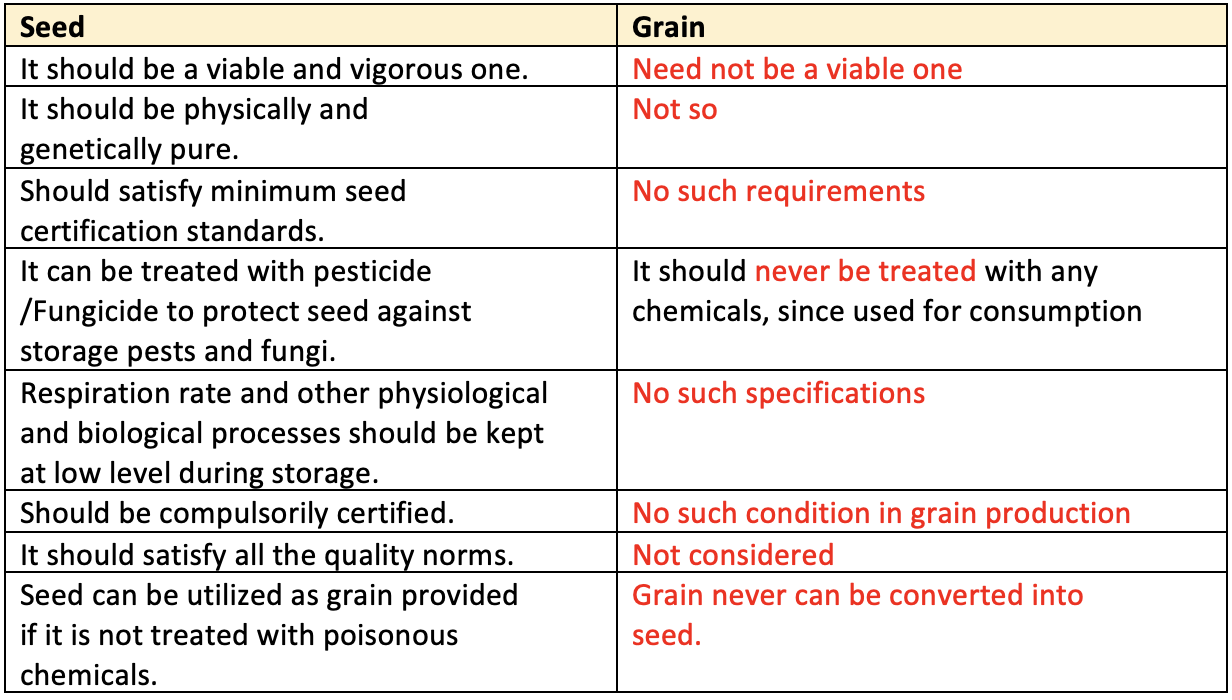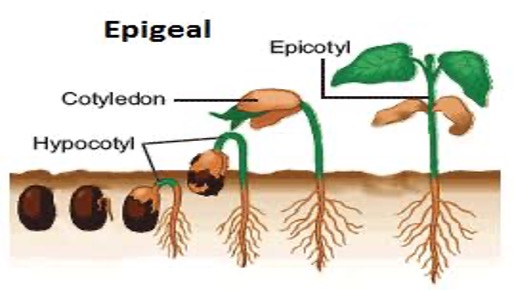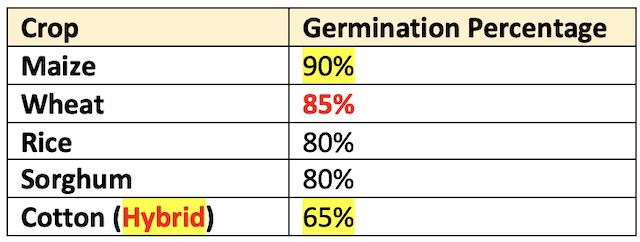🌱 Seed Testing
Seed, Characteristics, Seed Germination
Seed
- Seed is defined either Agronomically or Botanically.
- Botanically: “Seed is a fertilized ovule consisting of intact embryo, stored food and seed coat which is viable and has got the capacity to germinate.”
- Agronomically: “Seed is any material used for planting & propagation whether it is in the form of seed (grain) of food, fodder, fiber or vegetable crop or seedlings, tubers, bulbs, rhizomes, roots, cuttings, grafts or other vegetative propagated material."
Characteristics of the Seed
- It must be true to its type.
- The seeds must be healthy, pure and free from all inert materials and weed seeds.
- The seeds must be viable.
- The germination capacity is up to the standard and it has been tested recently.
- The seeds must be uniform in its texture, structure and look.
- The seeds should be truthfully labelled and produced under all due cares.
- The seed must not be affected by any seed-borne disease.
- It should be dry & not mouldy and should contain 12-14 per cent moisture.
- Seed health refers that the seed is free from any kind of disease propagule (spore, mycelium, etc.), either active or latent.
Difference between Seed and Grain

Seed testing
- First Seed Testing Laboratory was established at
IARIin 1961.
Seed Germination
- Germination is the emergence and development of seedling from the seed-embryo which is able to produce a normal plant under favourable condition.
- Agronomically germination means the capacity of seeds to give rise to normal sprouts within a definite period fixed for each crop under optimum field conditions.
- Changes during Germination
- Swelling of seed due to imbibition of water by osmosis.
- Initiation of physiological activities such as respiration & secretion of enzyme.
- Digestion of stored food by enzymes.
- Translocation & assimilation of soluble food.
- When seed is placed in soil gets favorable conditions, radical grows vigorously & comes out through micropyle & fixes seed in the soil. Then either hypocotyl or epicotyls begins to grow.
Types of Germination
Hypogeal germination
- The cotyledons remain under the soil. E.g.
Cereals,Pulses,Gram,Arhar,Lentil.

Epigeal germination
- The cotyledons pushed above the soil surface. E.g. [Oil seeds] Mustard, Tamarind, Sunflower, Castor, Onion.

👉🏻 Four essential factors for germination of seeds:
- Capacity of seed to germinat
- Moisture
- Temperature
- Oxygen-supply (Air)
👉🏻 Factors affecting the emergence of seedlings are:
- Deep sowing or depth of soil cover over the seed
- Inadequate or excess soil moisture
- Poor aeration
- Higher soil compaction or impermeable layer of soil or outer material
- Low temperature
- Rapid desiccation of soil
- Longer time perio
- Injurious level of salt content
- Poor seed capacity
- Detrimental physical, chemical and biological soil conditions
- Field germination is always lower than the germination of seeds tested in Laboratory. The mortality of seedlings after germination in the field frequently depends upon entomological, phytopathological, edaphological and meteorological factor as well as toxic effects of organic secretions and applied chemicals and storage period of the seed i.e. ageing.
- Germination tests are always carried out with the seeds counted of at random from the pure fraction of seeds. In accordance with the I.S.T.A. rules, a minimum number of 400 seeds are required for
germination test.

In general, the mortality of seedlings is more in kharif than rabi. So, germination of Rabi crops is more.
Methods for Testing Germination
1. Petridis Method
- Two blotters or filter papers are placed on the bottom of the petridish and they are soaked with water. A convenient number of seeds, ranging from 10-20, are placed on the surface of water-soaked blotters in the petridish. The kind of seed, date and time of seed soaking are written on the glass-cover of petridish with the help of a glass marking pencil.
- Usually, the germination percentage is calculated in two counts and reported on the basis of the results of germination of about 100 to 200 seeds. This method is suitable for small seeds viz. tobacco, tomato, radish, knol-khol, cabbage, cauliflower, mustard, lettuce, brinjal, chillies, etc.
2. Rolled Towel Method
- Two wet towels are placed on a smooth table top. The appropriate number of seeds are placed on the upper surface of the towels and are covered by two wet towels. A fold is made of the bottom of the towel to prevent the seeds from falling out. The towels are then rolled from right to left.
- The full informations regarding the test i.e. the kind of seed, lot number, date and time of seed soaking are noted on the roll with the help of an indelible pencil. This method is suitable for comparatively large sized seeds viz. maize, wheat, pea and gram.
3. Folder Paper Towel Method
- Two wet paper towels (big bamboo sheets), specially made for germination test, are placed on the working table-top. The surface of paper-towel is marked into two halves. The right half of the towel surface is planted with seeds and the left side half is folded to cover the right half and informations regarding the seed sample, date and time of seed soaking are written on the fold with an indelible pencil.
- Water is frequently sprinkled on these towels and observations on germinating seedlings and their numbers are taken periodically. This method of germination test is convenient for relatively large sized seeds.
4. Sand Method
- Seeds are planted in uniform layer of moist sand and then covered to depth of 1-2 cm with sand. Substrates for germination are moistened with 0.2 per cent KNO3 solution.
5. Rags or Gunny Sacs Method
- The seeds are simply wrapped in a moistened rag or gunny sac, which is then rolled and tied loosely in the form of bundle. This is now kept at a proper a temperature on a rack or convenient place for germination.
- The rolls are opened after a fixed period of time and the number of germinated seeds is counted.
6. Mechanical Method
- In this method, apparatus like Germinators are used. Cabinets of the incubator type with thermostatically controlled temperature may be used for the purpose.
- In these cabinets the seeds may be placed evenly on moist filter paper in petri dishes or between filter papers kept moist by folds of moistened flannel or large seeds be sown in dishes containing sand or fine soil. Adequate water is applied needed by the help of a wash-bottle or sprayer.
Seed Purity
- The purity of seed denotes the real percentage of desirable seed from a lot of with several impurities i.e. seeds of other varieties, other crop seed, defectives seeds, weeds seeds, inert matter, sand straw, stones, soil and iron particles, pebbles etc.

- Dockage is the impurity percentage of seed.

- Genetic purity is tested by Field Plot test.
Real Value of Seed
- The real value of seed represents its seed quality in terms of purity and germination.
- It can be evaluated by multiplying the purity percentage and germination percentage of a seed sample and dividing the product by 100.

- Real Value (RV) is expressed in percentage known as
Utility percentageof seed. - Conditions affecting the real value of seeds are the method of production, the method of handling and the method of storage. Seeds having a real value lower than 70% are usually not preferred for sowing purposes because of poor germination and purity values.
Seed
- Seed is defined either Agronomically or Botanically.
- Botanically: “Seed is a fertilized ovule consisting of intact embryo, stored food and seed coat which is viable and has got the capacity to germinate.”
- Agronomically: “Seed is any material used for planting & propagation whether it is in the form of seed (grain) of food, fodder, fiber or vegetable crop or seedlings, tubers, bulbs, rhizomes, roots, cuttings, grafts or other vegetative propagated material."
Characteristics of the Seed
- It must be true to its type.
- The seeds must be healthy, pure and free from all inert materials and weed seeds.
- The seeds must be viable.
- The germination capacity is up to the standard and it has been tested recently.
- The seeds must be uniform in its texture, structure and look.
- The seeds …
Become Successful With AgriDots
Learn the essential skills for getting a seat in the Exam with
🦄 You are a pro member!
Only use this page if purchasing a gift or enterprise account
Plan
Rs
- Unlimited access to PRO courses
- Quizzes with hand-picked meme prizes
- Invite to private Discord chat
- Free Sticker emailed
Lifetime
Rs
1,499
once
- All PRO-tier benefits
- Single payment, lifetime access
- 4,200 bonus xp points
- Next Level
T-shirt shipped worldwide

Yo! You just found a 20% discount using 👉 EASTEREGG

High-quality fitted cotton shirt produced by Next Level Apparel